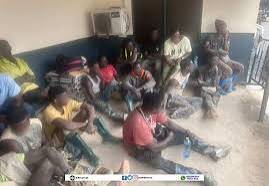A Personal Take on the Wassa Galamsey Arrests: What Are We Really Mining For?
A few years ago, I visited a small town in the Western Region of Ghana. It was the kind of place where time felt a bit slower, and everyone seemed to know each other’s grandmother. But what struck me most wasn’t the hospitality or the smell of fresh kenkey being sold by the roadside—it was the river. Murky. Brown. And oddly quiet. One of the locals pointed at it and said, “This used to be our pride. Kids swam here every weekend. Now? You’ll come out with a rash.â€
That moment stayed with me. So when I read that police had arrested 23 people and seized 64 changfans (those floating machines used in illegal mining) during anti-galamsey operations in Wassa, it hit me differently. It’s not just about the arrests—it’s about what we’re losing and, maybe, what we’re ignoring.
Let’s be real—galamsey isn’t a new story. It’s been simmering under the surface of our national conversation for years. We talk about it during election seasons, whenever the rivers turn to sludge, or when someone posts a viral video of destroyed cocoa farms on TikTok. But here’s the thing: nothing ever seems to really change. The players switch, the headlines fade, and the excavators magically disappear after being “seized.â€
Now, don’t get me wrong—I’m glad the police are doing something. Twenty-three arrests and 64 changfans off the rivers? That’s not nothing. But I can’t help wondering… is this just a temporary cleanup or a real turning point?
See, in my experience, problems like galamsey go deeper than machines and arrests. It’s about desperation, broken systems, and people trying to survive—sometimes at the expense of the land that gave them life. Some of these miners aren’t hardened criminals. They’re young guys, maybe even single mothers or farmers-turned-miners, who felt like there were no other options. Does that excuse the damage? No. But it explains the persistence.
And let’s talk about the changfans. Sixty-four? That’s a whole fleet. I once joked with a friend that you could build a floating city with all the galamsey equipment they’ve confiscated over the years. Where do they all go? Who buys them? Who’s bringing them in? It’s the kind of stuff that makes you raise an eyebrow and start questioning who’s really behind the curtain.
Honestly, I wasn’t sure if writing this would matter. It’s easy to feel powerless. But I believe that stories like these—real stories, not just statistics—deserve to be told. Because behind those numbers are communities dealing with polluted water, destroyed farmlands, and kids growing up thinking muddy rivers are normal.
Maybe I’m just venting. Or maybe I’m hoping someone in a better position will read this and think, we can’t keep doing this. We can’t keep patching up bullet wounds with band-aids.
So here’s my question: If we’re serious about stopping galamsey, are we just chasing miners—or are we finally ready to dig deeper?
Let that sit with you.


